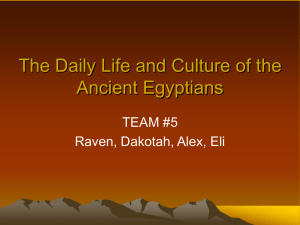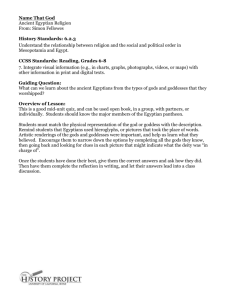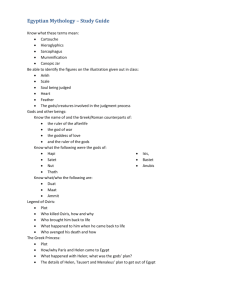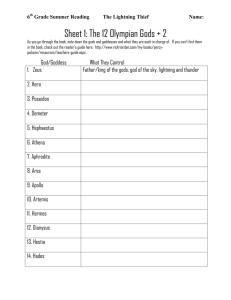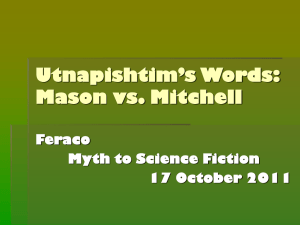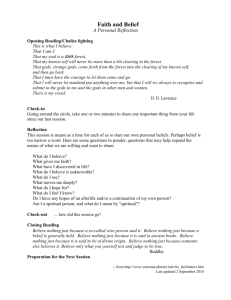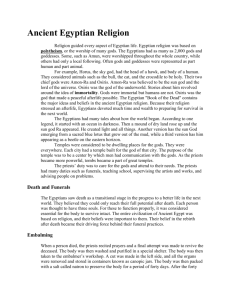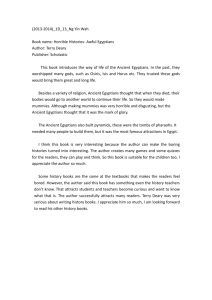Religion penetrated every layer of Egyptian society in the
advertisement
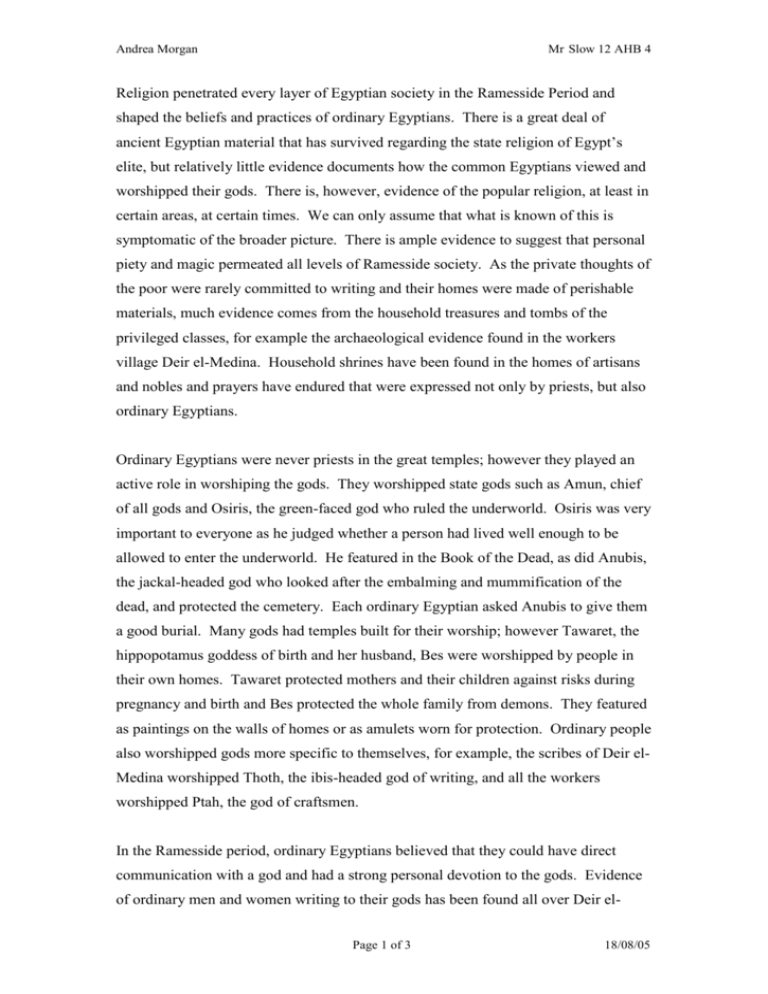
Andrea Morgan Mr Slow 12 AHB 4 Religion penetrated every layer of Egyptian society in the Ramesside Period and shaped the beliefs and practices of ordinary Egyptians. There is a great deal of ancient Egyptian material that has survived regarding the state religion of Egypt’s elite, but relatively little evidence documents how the common Egyptians viewed and worshipped their gods. There is, however, evidence of the popular religion, at least in certain areas, at certain times. We can only assume that what is known of this is symptomatic of the broader picture. There is ample evidence to suggest that personal piety and magic permeated all levels of Ramesside society. As the private thoughts of the poor were rarely committed to writing and their homes were made of perishable materials, much evidence comes from the household treasures and tombs of the privileged classes, for example the archaeological evidence found in the workers village Deir el-Medina. Household shrines have been found in the homes of artisans and nobles and prayers have endured that were expressed not only by priests, but also ordinary Egyptians. Ordinary Egyptians were never priests in the great temples; however they played an active role in worshiping the gods. They worshipped state gods such as Amun, chief of all gods and Osiris, the green-faced god who ruled the underworld. Osiris was very important to everyone as he judged whether a person had lived well enough to be allowed to enter the underworld. He featured in the Book of the Dead, as did Anubis, the jackal-headed god who looked after the embalming and mummification of the dead, and protected the cemetery. Each ordinary Egyptian asked Anubis to give them a good burial. Many gods had temples built for their worship; however Tawaret, the hippopotamus goddess of birth and her husband, Bes were worshipped by people in their own homes. Tawaret protected mothers and their children against risks during pregnancy and birth and Bes protected the whole family from demons. They featured as paintings on the walls of homes or as amulets worn for protection. Ordinary people also worshipped gods more specific to themselves, for example, the scribes of Deir elMedina worshipped Thoth, the ibis-headed god of writing, and all the workers worshipped Ptah, the god of craftsmen. In the Ramesside period, ordinary Egyptians believed that they could have direct communication with a god and had a strong personal devotion to the gods. Evidence of ordinary men and women writing to their gods has been found all over Deir elPage 1 of 3 18/08/05 Andrea Morgan Mr Slow 12 AHB 4 Medina. On stone stelae standing in shrines, on ostraca and papyrus and in the tombs of the workers outside the village they wrote questions and prayers to the gods. Ordinary people who were not priests were not allowed to enter the temples. Ears were carved on the outside walls of important temples so that ordinary people could whisper their prayers directly to the gods. The open courtyards of the temple to Amun at Luxor and the Hypostyle Hall of the Karnak temple bear inscriptions indicating that by the Ramesside period members of the public were able to assemble and praise the king and experience the manifestation of the gods. Offerings to the gods: food, flowers, or votive stelae, could be made in the outer temple courts. Ordinary Egyptians could also approach their gods through oracles which could answer their important questions, usually by a yes or no answer. Amun was well known as a god ‘who listened to prayers.’ He was often depicted on stelae as a pair of ears, for example this stela found in Deir el-Medina, which depicts the workman Bai praying to Amun.1 Ordinary Egyptians also believed that they would be severely punished by the gods for their crimes. For example, on Neferabu’s stela he claims Ptah to have taken away his sight, “I am a man who swore falsely by Ptah…and he made me see darkness by day.”2 Magic was an important aspect of the religious beliefs and practices of ordinary Egyptians during the Ramesside period. They believed that magic was part of the working of the universe. Every religious ceremony included magic spells and actions. Egyptians believed that their gods used magic to deal with their enemies, overcome evil or bad luck and to heal the sick. They also believed that that the gods had given the people on earth these magic powers to help them overcome the dangers of life and death. Ordinary Egyptians wore amulets in the belief that they had magical powers to protect the wearer. Three amulets that were popular were the Ankh, the symbol of life, the Djed Pillar, the symbol of Osiris and the Wedjat, the left eye of the god Horus. They also believed that the dead needed amulets. The scarab amulet was wrapped in the bandages of the mummy and was believed to have the magical power to lift the heart and make it lighter on the judgment scales before the gods. Many were inscribed with the words, ‘O my heart do not betray me.’ Many people also 1 Stela of Bai in Demovic, M. & Hayes, M. Deir el Medina and Pompey, Addison Welsley Longman, Australia, 1996.ch.10. Page 2 of 3 18/08/05 Andrea Morgan Mr Slow 12 AHB 4 wore amulets of Khnum, the controller of the Nile, which was vital to Egypt’s existence. The painted scenes in the workmen’s tombs and the number of village and household shrines and stelae at Deir el-Medina indicate that the villagers and presumably other ordinary Egyptians had a strong personal devotion to the gods. Magic and personal piety were both important aspects of their religious beliefs and worship of the gods. This is reflected through their religious practices and the wealth of archaeological evidence from Deir el-Medina. However, not all common Egyptians were pious. There is evidence of tomb robberies occurring in the 20th dynasty during the reign of Rameses IX. The trials of the robbers recorded on now-damaged papyrus, held in the Turin Museum and the British Museum, suggest that along with the pious, there was an element of the population that had little regard for the gods and the results of their actions in the afterlife. 2 Stela of Neferabu in Demovic, M. & Hayes, M. Deir el Medina and Pompey, Addison Welsley Longman, Australia, 1996.ch.10. Page 3 of 3 18/08/05
